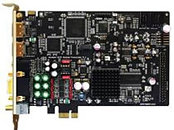Monday, June 16th 2008
Auzentech Preps HDMI 1.3 PCI Express Audio Combo Card
Auzentech revealed today its non-downsampling, HDMI 1.3-native, PCI express audio combo card: Auzen X-Fi HomeTheater 7.1. The Auzen X-Fi HomeTheater 7.1 accepts video from either an internal or external connection, mixes it with digital audio, and outputs the combined video and lossless multichannel audio via a single HDMI 1.3 port. Moreover, the internal connection will exclusively support upcoming NVIDIA products, to create the ultimate in audio and visual entertainment.The latest in a long line of breakthrough soundcards from Auzentech, the Auzen X-Fi HomeTheater 7.1 outputs a bitstream of high-definition, multichannel audio from Blu-ray or HD movies with no downsampling, to take full advantage of lossless digital audio formats such as Dolby TrueHD and DTS-HD Master Audio.
The Auzen X-Fi HomeTheater 7.1 has been designed around the latest Creative PCI Express X-Fi audio processor. For home theater enthusiasts, the processor includes HDMI 1.3 support and will feature Dolby Digital and DTS encoding for a single-cable connection to home theater systems. For gamers, the card leverages the power of the PCI Express-optimized X-Fi processor to deliver accelerated audio for improved game performance, with ultra-realistic EAX 5.0 effects and 3D positional audio.
"Creative is excited to work with Auzentech to deliver a true high-definition HDMI solution based on our latest PCI Express-based processor," said Steve Erickson, VP and GM of audio for Creative. "We have completely re-architected our X-Fi audio processor, optimizing it for the PCI Express bus. We've also made a significant achievement in customizing our audio technology to enable the highest quality lossless digital audio for HDMI, for a stunning HD digital entertainment experience."
"CyberLink provides the best in audio and video playback quality to deliver the ultimate movie experience on the PC," said Alice H. Chang, CEO of CyberLink. "Featuring HDMI version 1.3-enabed capabilities, PowerDVD will enable users to enjoy high definition cinema on their PCs. We are excited to partner with Auzentech to offer a true, uncompressed HD audio experience by employing our breakthrough technologies."
"At Auzentech we focus on bringing innovative products to market by listening to our end-users requests," said Stephane Bae, President of Auzentech, Inc. "By teaming up with Industry leaders Creative, NVIDIA, CyberLink and Silicon Image, end users and home theater enthusiasts will now be able to enjoy Blu-Ray or HD movies in their full glory."
The Auzen X-Fi HomeTheater 7.1 is made possible through cooperation between Auzentech, NVIDIA, CyberLink PowerDVD software, Silicon Image, and the Creative X-Fi chip development team.
Release of the Auzen X-Fi HomeTheater 7.1 is planned for Sept. of 2008.
Source:
Auzentech
The Auzen X-Fi HomeTheater 7.1 has been designed around the latest Creative PCI Express X-Fi audio processor. For home theater enthusiasts, the processor includes HDMI 1.3 support and will feature Dolby Digital and DTS encoding for a single-cable connection to home theater systems. For gamers, the card leverages the power of the PCI Express-optimized X-Fi processor to deliver accelerated audio for improved game performance, with ultra-realistic EAX 5.0 effects and 3D positional audio.
"Creative is excited to work with Auzentech to deliver a true high-definition HDMI solution based on our latest PCI Express-based processor," said Steve Erickson, VP and GM of audio for Creative. "We have completely re-architected our X-Fi audio processor, optimizing it for the PCI Express bus. We've also made a significant achievement in customizing our audio technology to enable the highest quality lossless digital audio for HDMI, for a stunning HD digital entertainment experience."
"CyberLink provides the best in audio and video playback quality to deliver the ultimate movie experience on the PC," said Alice H. Chang, CEO of CyberLink. "Featuring HDMI version 1.3-enabed capabilities, PowerDVD will enable users to enjoy high definition cinema on their PCs. We are excited to partner with Auzentech to offer a true, uncompressed HD audio experience by employing our breakthrough technologies."
"At Auzentech we focus on bringing innovative products to market by listening to our end-users requests," said Stephane Bae, President of Auzentech, Inc. "By teaming up with Industry leaders Creative, NVIDIA, CyberLink and Silicon Image, end users and home theater enthusiasts will now be able to enjoy Blu-Ray or HD movies in their full glory."
The Auzen X-Fi HomeTheater 7.1 is made possible through cooperation between Auzentech, NVIDIA, CyberLink PowerDVD software, Silicon Image, and the Creative X-Fi chip development team.
Release of the Auzen X-Fi HomeTheater 7.1 is planned for Sept. of 2008.

30 Comments on Auzentech Preps HDMI 1.3 PCI Express Audio Combo Card
It gets audio and video over the one cable, a noble goal.